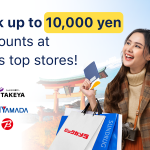Mexico is a country full of color, music, and flavor. From street corners to local markets, food is everywhere—and it’s amazing. Most people know tacos, but Mexican food is so much more. Every region has its own special dishes. Each one tells a story through taste, smell, and tradition. If you’re planning a trip, learning about the best local foods to try in Mexico is a must. You’ll find rich, slow-cooked sauces in Oaxaca, fresh seafood in Baja California, and spicy snacks on every street.
Eating like a local is one of the best ways to feel the heart of Mexico. So grab a napkin and get ready—your food adventure starts now.
In Mexico, everything on the street is a celebration of flavor.
Unknown
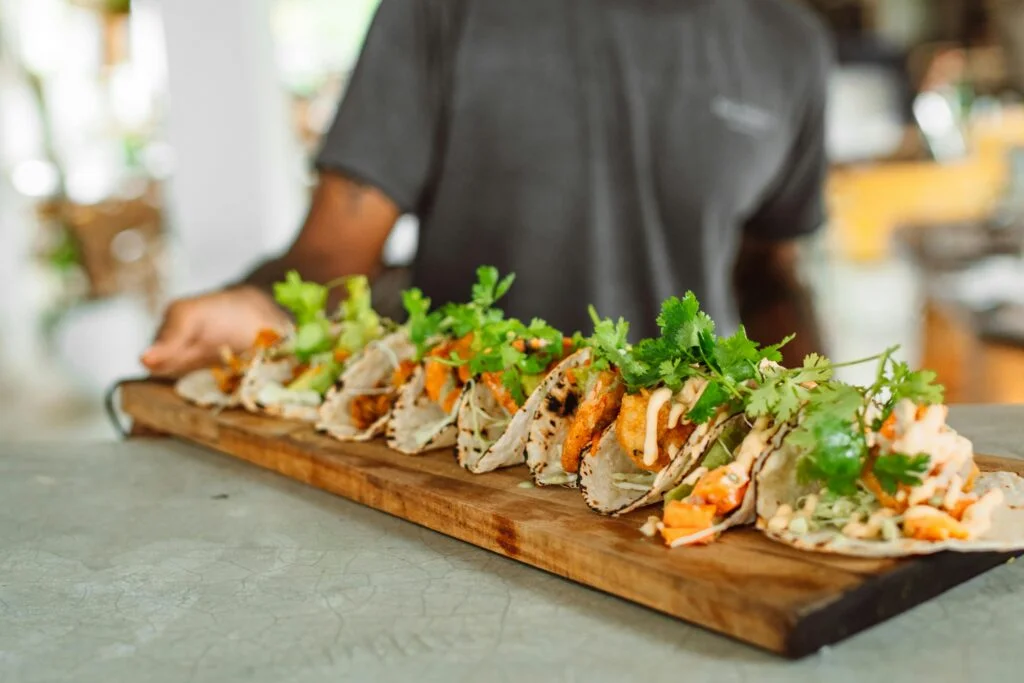
Image: Mexican Tacos on the Wooden Board
Before embarking on your Mexican food adventure, ensure you have reliable connectivity to share your culinary discoveries with friends and family. Gohub’s international eSIM solutions offer seamless internet access throughout Mexico, allowing you to post those mouthwatering food photos without worrying about expensive roaming fees or unreliable public WiFi.
I. The Cornerstone of Mexican Cuisine: Tacos and Their Infinite Varieties
When it comes to the best local foods to try in Mexico, tacos are non-negotiable. But forget the crunchy shells you might see abroad—authentic Mexican tacos are soft, fresh, and endlessly creative.
Authentic Mexican Tacos: A Street Food Revolution
You simply can’t explore Mexican cuisine without talking about tacos. But forget the crunchy, pre-packed versions you might know—real Mexican tacos are a different world entirely.
Served on soft corn or flour tortillas, they’re filled with everything from marinated meats to grilled veggies, spicy sauces, and fresh toppings. And the best part? No two tacos are the same.
Across Mexico, every region—and often every street corner—puts its own spin on this iconic dish. It’s fast, flavorful, and deeply tied to local culture, making tacos the heart and soul of Mexican street food.
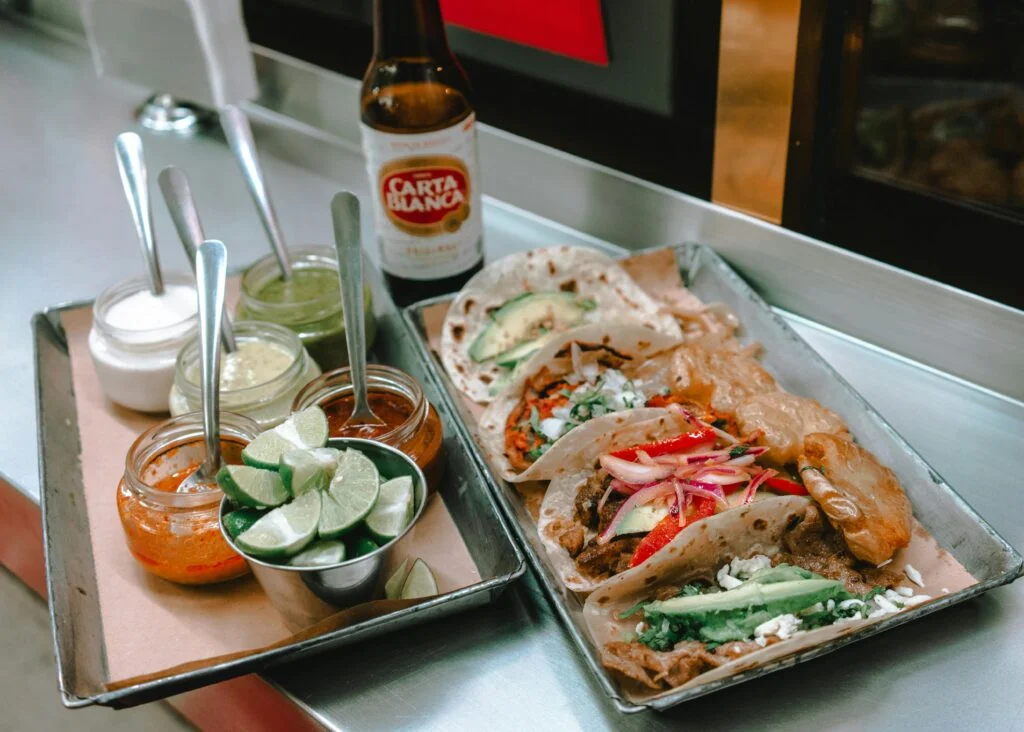
Tacos al Pastor: Mexico City’s Crown Jewel
If there’s one taco you have to try in Mexico City, it’s tacos al pastor. This local favorite features thin slices of marinated pork, slow-roasted on a spinning vertical spit—a method inspired by Lebanese immigrants and their shawarma.
The pork is juicy, flavorful, and slightly charred at the edges. It’s served on soft tortillas and topped with chopped onion, fresh cilantro, and a slice of sweet pineapple that perfectly balances the spice. One bite, and you’ll understand why locals line up for it day and night.
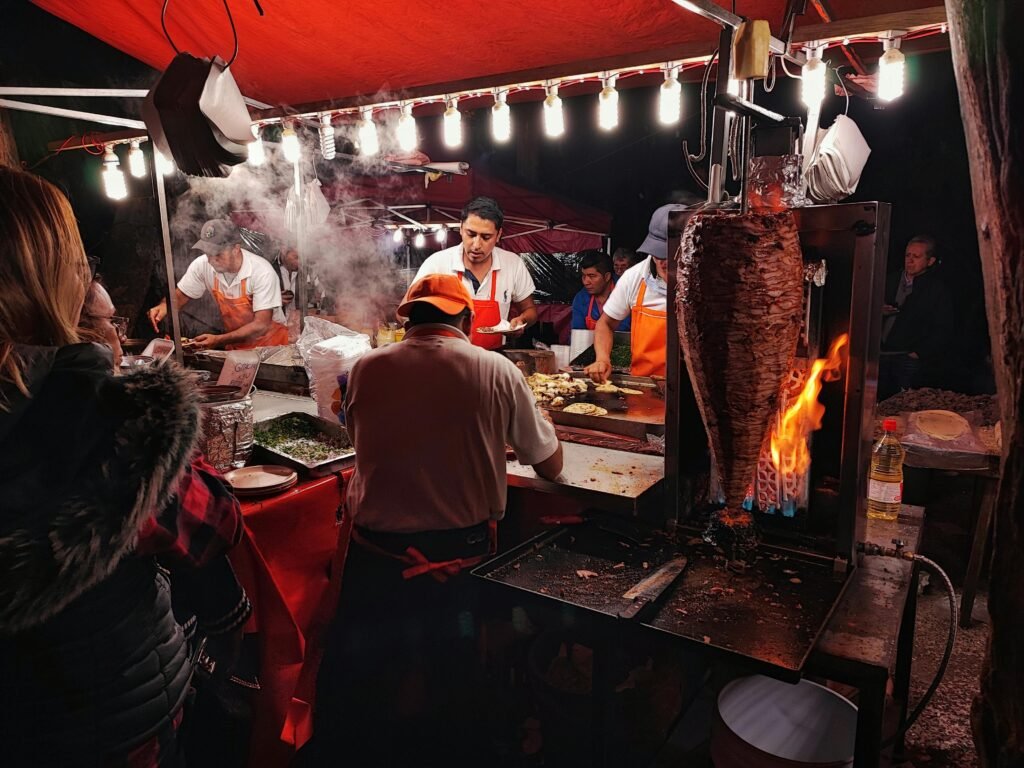
Image: Tacos al Pastor being prepared on a traditional vertical spit with pineapple on top
Regional Taco Varieties You Shouldn’t Miss
Beyond tacos al pastor, Mexico is home to a stunning variety of regional tacos—each with its own flavor, story, and fan base. Here are a few you’ll want to track down on your travels:
- Carne Asada – These grilled beef tacos are a staple across northern Mexico. The meat is juicy, charred just right, and often served with guacamole or roasted chilies.
- Carnitas – A Michoacán specialty, carnitas are made by slow-cooking pork in its own fat until it’s crispy on the outside, tender on the inside. Add some pickled onions and salsa verde, and you’re in taco heaven.
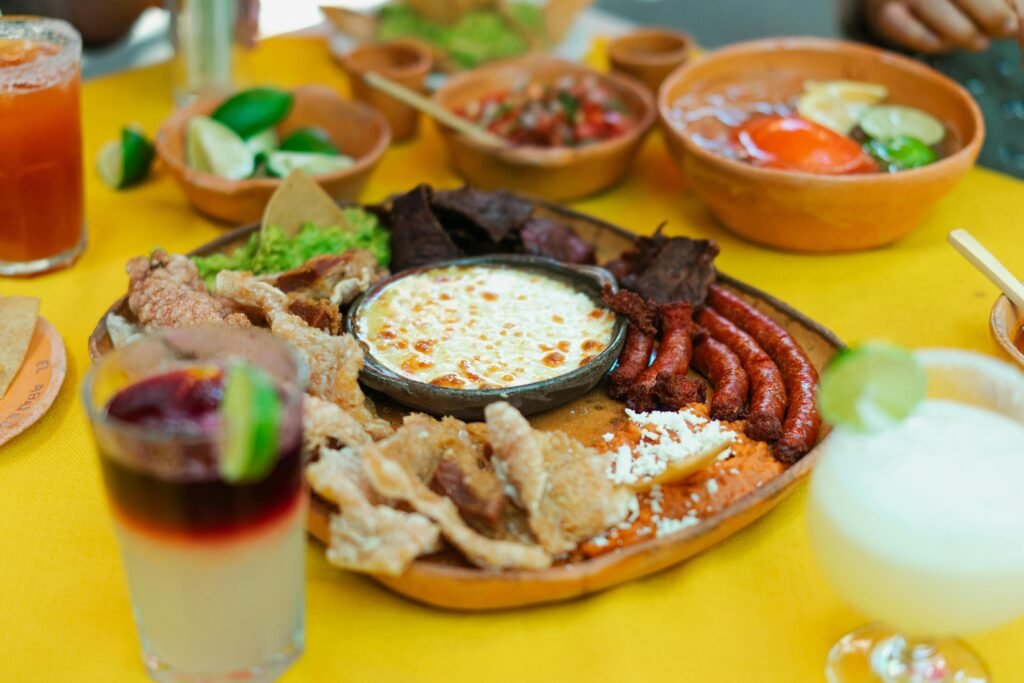
- Fish Tacos (Tacos de Pescado) – These tacos come from Baja California. They have crispy fried white fish, topped with cabbage and creamy sauce. Fresh, light, and full of flavor.
- Goat Tacos (Cabrito) – Popular in Monterrey, these tacos are made with tender roasted goat meat. They’re rich, juicy, and best with a little salsa.
- Vegan Tacos – In big cities like Mexico City, you’ll find plant-based tacos with things like cactus (nopales), corn fungus (huitlacoche), and squash flowers. They’re creative, tasty, and perfect for anyone who doesn’t eat meat.
💡 Travel Tip
Want real, delicious tacos? Look for street stalls with long lines of locals—that’s always a good sign. Skip the touristy spots and explore side streets. You’ll eat better and pay less.
And to make it easier, use a Gohub eSIM for Mexico. It helps you stay online with maps and translation apps, so you can find the best tacos—no roaming fees, no SIM card hassle.
☀️ Planning your food trip around the seasons? Here’s the best time to visit Mexico — so you can catch both the festivals and the freshest flavors.
Want to learn more about the roots of traditional Mexican dishes? Check out this deep dive into Mexican cuisine on Britannica.
II. Beyond Tacos: Essential Traditional Mexican Dishes
While tacos may steal the spotlight, Mexican cuisine is much deeper than tortillas and fillings. Across the country, you’ll find dishes that have been passed down for generations—meals filled with history, meaning, and bold regional flavors.
From soft, steamed tamales to rich, slow-cooked pozole, these traditional dishes are a must-try for anyone craving the real taste of Mexico.
Tamales: Ancient Comfort Food Wrapped in Tradition
Tamales are one of the oldest traditional foods in Mexico, dating back to pre-Hispanic times. They’re made with soft corn dough (masa), filled with tasty ingredients like meat, cheese, or even sweet fillings, then wrapped in corn husks or banana leaves and steamed until warm and tender.
You’ll find many types of tamales across Mexico, each with its own flavor and twist:
- Tamales Verdes – Filled with chicken and green salsa
- Tamales Rojos – Pork with red chili sauce
- Tamales Dulces – Sweet versions with fruit, nuts, or chocolate
- Tamales Oaxaqueños – Wrapped in banana leaves for a soft texture and unique taste
Tamales aren’t just everyday food—they’re part of the celebration. Especially during holidays like Día de la Candelaria (February 2), families gather to make and enjoy them together, keeping this flavorful tradition alive.

Image: Assortment of traditional Mexican tamales unwrapped to show different fillings
Pozole: A Hearty Pre-Hispanic Stew
If you’re looking for authentic Mexican food with real history, pozole is a must-try. This warm, comforting stew has been around since before the Spanish arrived. It’s made with hominy corn (a special type of puffed corn) cooked in a rich broth, often with pork or chicken, and topped with fresh veggies like shredded lettuce, radish, onion, lime, and chili.
The Three Colors of Pozole
ust like the Mexican flag, pozole comes in three classic versions:
- Pozole Rojo – Red broth made with dried red chilies
- Pozole Verde – Green version using tomatillos and green chilies
- Pozole Blanco – The simplest form, with no added sauce—just pure, clean flavor
Pozole is more than just a meal—it’s a dish for special days. You’ll often see it at holidays and family gatherings, but it’s also served year-round in restaurants that focus on traditional Mexican dishes.

Image: Bowl of red pozole garnished with traditional toppings
III. The Art of Complexity: Mole and Regional Specialties
Once you’ve tried the everyday favorites, it’s time to explore the more complex side of Mexican cuisine—where sauces tell stories and every bite is steeped in history.
Mole: Mexico’s Most Complex Culinary Achievement
Among all the best local foods to try in Mexico, mole is one of the most unique—and unforgettable.
Originally from Puebla and Oaxaca, mole is a rich, complex sauce made from dozens of ingredients like dried chiles, chocolate, nuts, seeds, spices, and sometimes fruit. It’s usually served over chicken or turkey, and every bite is bold, deep, and full of surprises.
The Seven Moles of Oaxaca
Oaxaca is known as the “land of seven moles.” Each one has its own color, taste, and story:
- Mole Negro – The most famous, dark and smoky with chocolate and many types of chiles
- Mole Rojo – A spicy red mole with balanced heat
- Mole Coloradito – Reddish-brown, slightly sweet
- Mole Amarillo – Yellow mole with herbs and yellow chiles
- Mole Verde – Bright green and fresh, made with herbs and seeds
- Manchamanteles – A fruity, spicy mole whose name means “tablecloth stainer”
- Chichilo – Rare and earthy, made with burnt chile seeds

Image: Plate of chicken with dark mole sauce garnished with sesame seeds
Trying mole isn’t just about taste—it’s about culture. It’s a dish that takes time, patience, and pride to make. And once you try it, you’ll understand why it’s considered the heart of Mexican culinary art.
If you’re a street food enthusiast, don’t miss Vietnam’s vibrant dishes.
IV. Regional Mexican Food Specialties You Can’t Miss
Mexico’s flavors change as you move from one region to another. These local dishes show off the country’s incredible diversity—and are a must-try if you want to taste the real Mexico.
Tlayudas: Oaxaca’s “Mexican Pizza”
Known as “Mexican pizza,” tlayudas are giant, crispy tortillas topped with refried beans, Oaxacan cheese (quesillo), lettuce, avocado, and grilled meat like tasajo (beef), cecina (pork), or chorizo. Crunchy, savory, and super satisfying—this street food is a local favorite in Oaxaca.
Cochinita Pibil: The Yucatán’s Signature Dish
From the Yucatán Peninsula, cochinita pibil is pork that’s marinated in citrus juice and achiote spice, then wrapped in banana leaves and slow-roasted until juicy and tender. It’s often served with pickled red onions and spicy habanero salsa. This dish reflects the deep Mayan roots in Yucatán cuisine.

Image: Cochinita pibil served with pink pickled onions and tortillas
Chiles en Nogada: Patriotic Culinary Art
This elegant dish looks like the Mexican flag on a plate. Green poblano peppers are stuffed with a sweet-savory meat and fruit mix, topped with creamy white walnut sauce (nogada), and sprinkled with ruby-red pomegranate seeds. Traditionally served in September, it’s a dish full of history, celebration, and flavor.
V. Street Food Culture: The Heart of Mexican Gastronomy
If you want to truly taste Mexico, head to the streets. Street food isn’t just convenient—it’s where some of the best local dishes are born, shared, and loved. It’s fast, affordable, and full of flavor you’ll remember long after your trip ends.
The vibrant street food scene is where you’ll find some of the best local foods to try in Mexico. Beyond tacos, street vendors offer an incredible array of authentic dishes at affordable prices.
Elote and Esquites: Mexico’s Beloved Corn Treats
Corn holds a sacred place in Mexican culture, and these popular street snacks showcase it perfectly:
- Elote: Grilled corn on the cob slathered with mayonnaise, cotija cheese, chile powder, and lime

- Esquites: The same delicious ingredients but with corn kernels served in a cup, making it easier to eat while walking
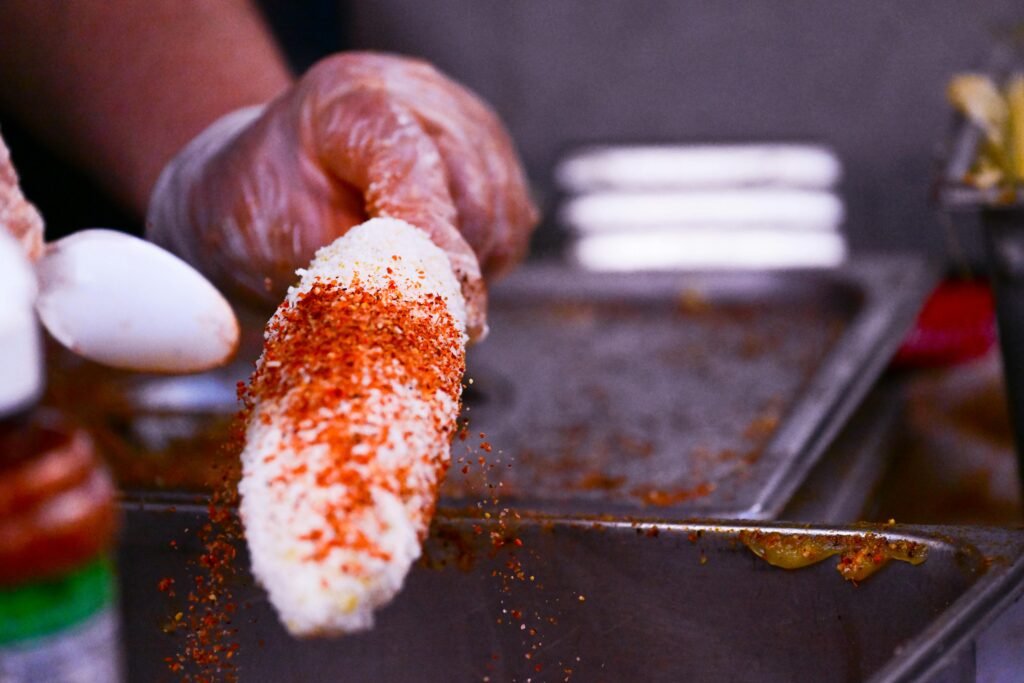
Image: Street vendor preparing elotes with traditional toppings:
Quesadillas: Not Just Cheese
While internationally known as simply cheese-filled tortillas, in Mexico (particularly Mexico City), quesadillas come with various fillings—sometimes even without cheese! Explore fillings like:
- Huitlacoche: Corn fungus with an earthy, mushroom-like flavor
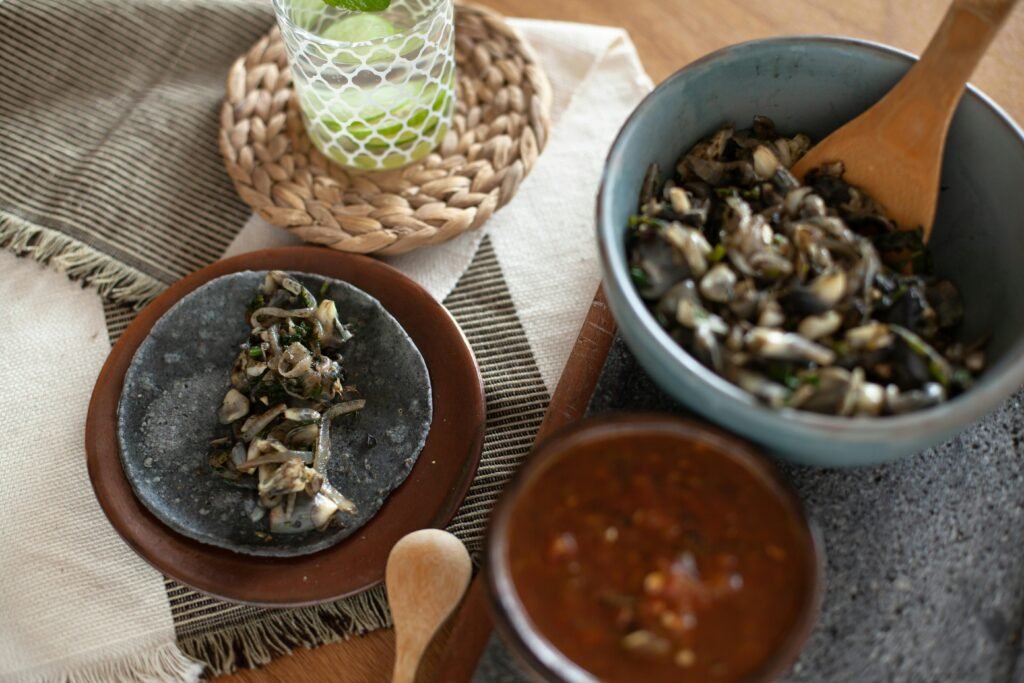
- Flor de Calabaza: Squash blossoms with a delicate flavor
- Chicharrón: Crispy pork skin, often stewed in salsa
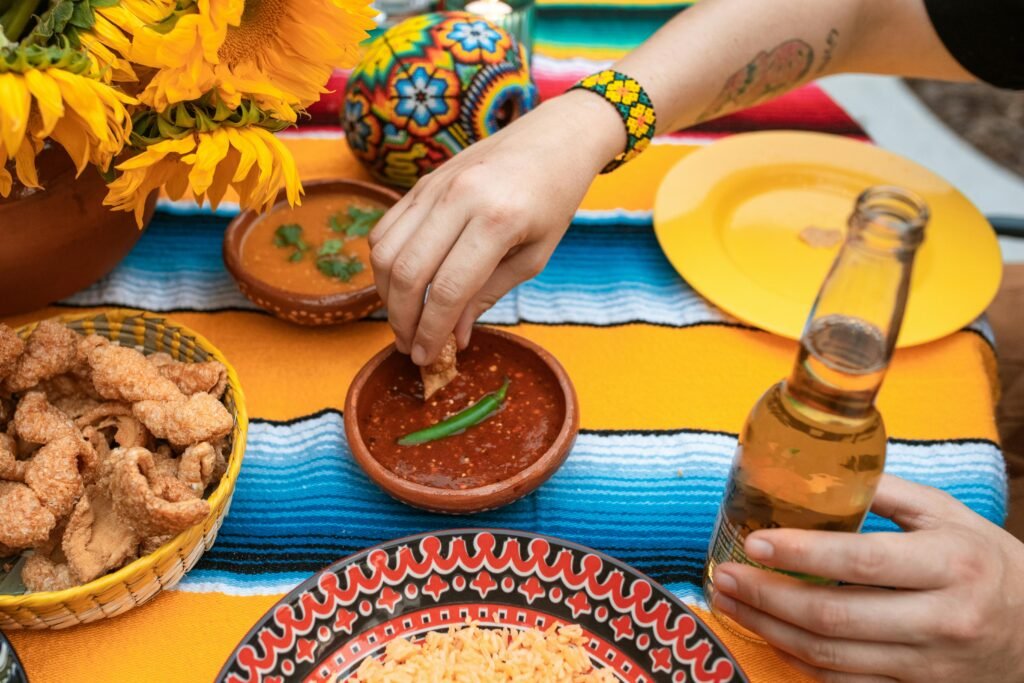
Tortas: Mexico’s Answer to the Sandwich
These hearty sandwiches served on bolillo rolls come filled with a variety of ingredients. Regional variations like the Torta Ahogada (“drowned sandwich”) from Guadalajara, soaked in spicy tomato sauce, offer a unique culinary adventure.
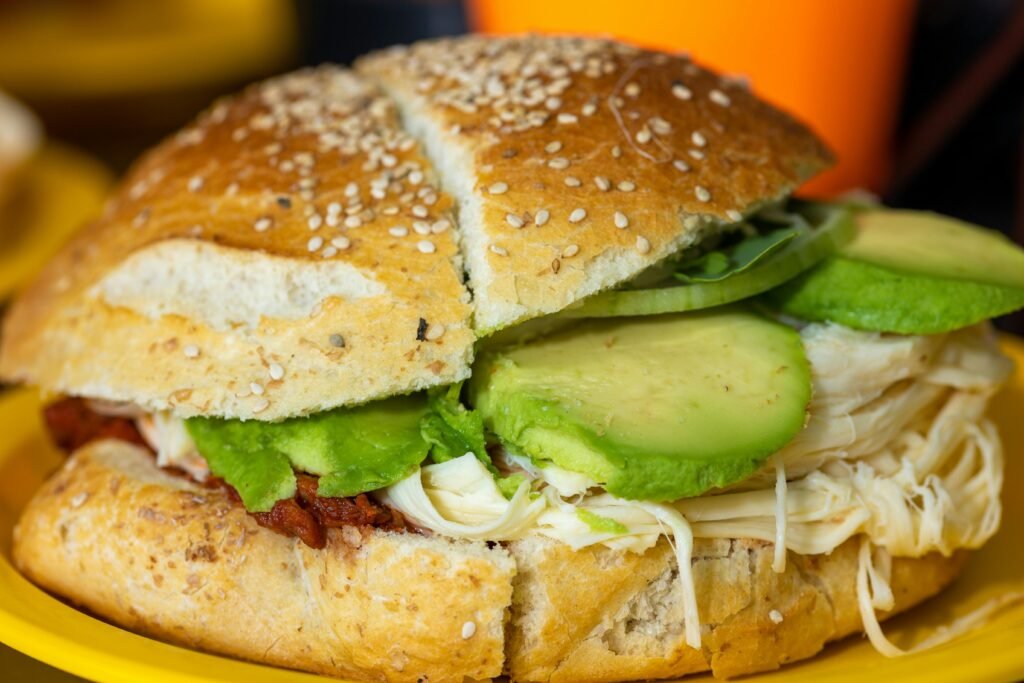
Connectivity Tip: When exploring street food markets, having reliable internet access is invaluable for translating menus, finding recommendations, and sharing your discoveries. Gohub’s international eSIM provides seamless connectivity throughout Mexico, ensuring you never miss a chance to document your culinary adventures.
Love the spice? Thai food fans will drool over these local foods in Thailand.
VI. The Tortilla Trinity: Enchiladas, Enmoladas, and Enfrijoladas
Tortillas are at the heart of Mexican food—and when paired with flavorful sauces, they transform into something truly special. These three classic dishes show just how versatile tortillas can be.
These three traditional Mexican dishes showcase the versatility of the tortilla when paired with different sauces:
Enchiladas: The Classic Tortilla Dish
Corn tortillas filled with various ingredients and covered in chile sauce, enchiladas come in countless regional variations:
- Enchiladas Suizas: Topped with cream sauce and cheese
- Enchiladas Potosinas: Distinctive red-colored tortillas from San Luis Potosí
- Enchiladas Mineras: A specialty of Guanajuato, filled with cheese and topped with potatoes and carrots
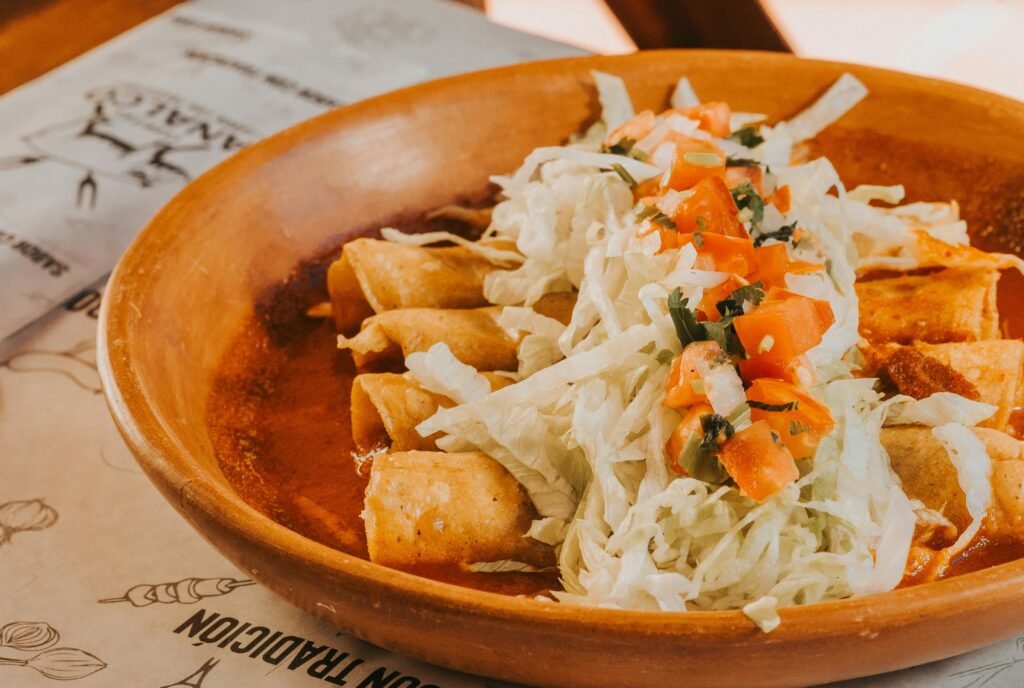
Image: Plate of enchiladas topped with cream, cheese and salsa
Enmoladas: Tortillas Bathed in Mole
Similar to enchiladas but covered in rich mole sauce instead of chile sauce, enmoladas offer a more complex flavor profile that showcases one of Mexico’s most distinctive culinary creations.
Enfrijoladas: Comfort Food at Its Finest
These tortillas covered in bean sauce represent Mexican comfort food at its best—simple yet satisfying. Typically topped with cheese, cream, and onions, enfrijoladas make a perfect breakfast or light dinner.
VII. Regional Mexican Cuisine: A Culinary Map of Mexico
Mexico’s food changes from region to region—and that’s exactly what makes it so exciting. From coastal seafood to highland spices, here’s a quick taste of what to try across the country.
Oaxaca: Mexico’s Culinary Heart
Known as the “land of seven moles,” Oaxaca offers some of the best local foods to try in Mexico. Beyond its famous moles, look for:
- Tlayudas: Large, crispy tortillas topped with beans, cheese, and meat

- Tetelas: Triangular corn masa pockets filled with beans
- Memelas: Thick corn tortillas topped with beans, cheese, and salsa
Yucatán Peninsula: Maya-Influenced Flavors
The Yucatán’s cuisine stands apart from the rest of Mexico due to its Mayan heritage and unique ingredients:
- Sopa de Lima: Chicken soup brightened with local lime
- Panuchos and Salbutes: Fried tortillas topped with various ingredients
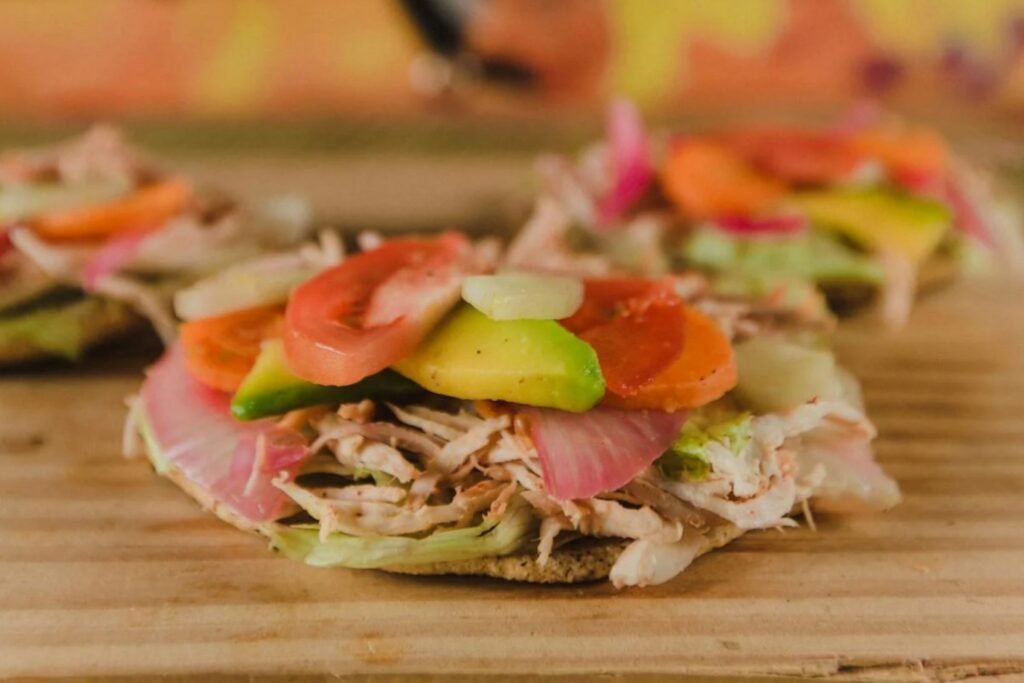
- Papadzules: Tortillas filled with hard-boiled eggs and covered in pumpkin seed sauce
Baja California: Seafood Paradise
With coastlines on both the Pacific Ocean and the Sea of Cortez, Baja California offers exceptional seafood dishes:
- Fish Tacos: The region’s claim to fame
- Aguachile: Raw shrimp cured in lime juice with chile, similar to ceviche

- Puerto Nuevo Lobster: A specialty of the small fishing village of Puerto Nuevo
Mexico City: A Culinary Melting Pot
As the country’s capital, Mexico City offers authentic Mexican food from every region, plus its own specialties:
- Tacos al Pastor: The city’s iconic taco

- Tortas: Especially from established venues like Tortas Don Armando
- Chilaquiles: The perfect breakfast after a night out
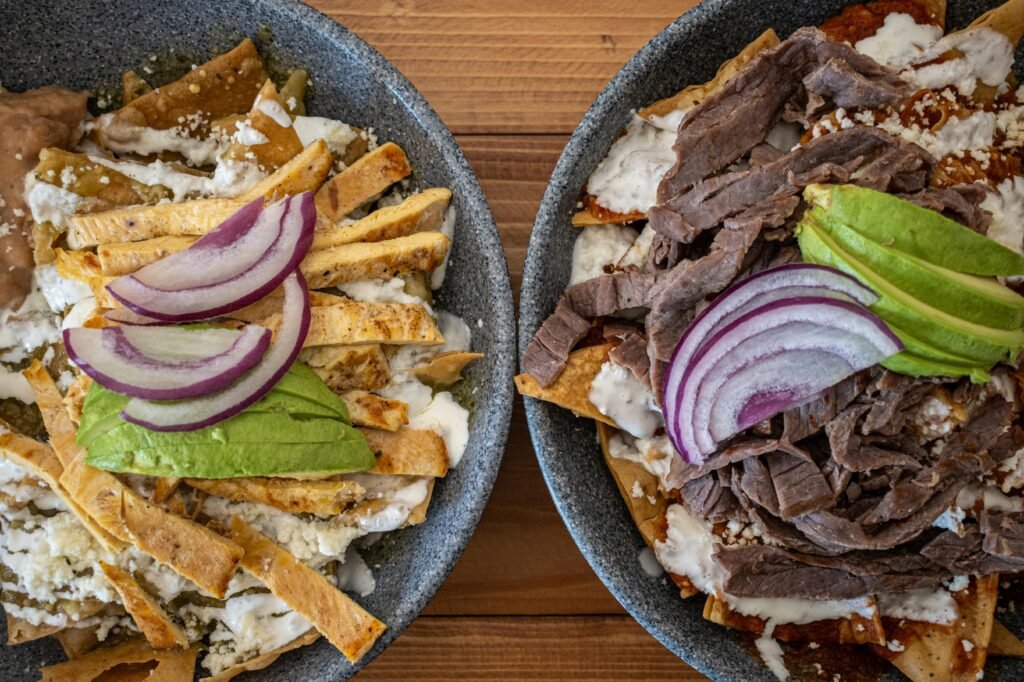
VIII. Sweet Endings: Mexican Desserts and Treats
No culinary journey through the best local foods to try in Mexico would be complete without sampling traditional sweets:
Churros: Crispy Fried Perfection
These golden sticks of fried dough are coated in cinnamon sugar and often served with chocolate or caramel for dipping. You’ll find them at night markets and street stalls—best eaten hot, fresh out of the fryer.
Flan: Silky Caramel Custard
Soft, creamy, and topped with caramel sauce, flan is a dessert you’ll spot on almost every menu. Though it came from Spain, it’s become a beloved treat across Mexico.
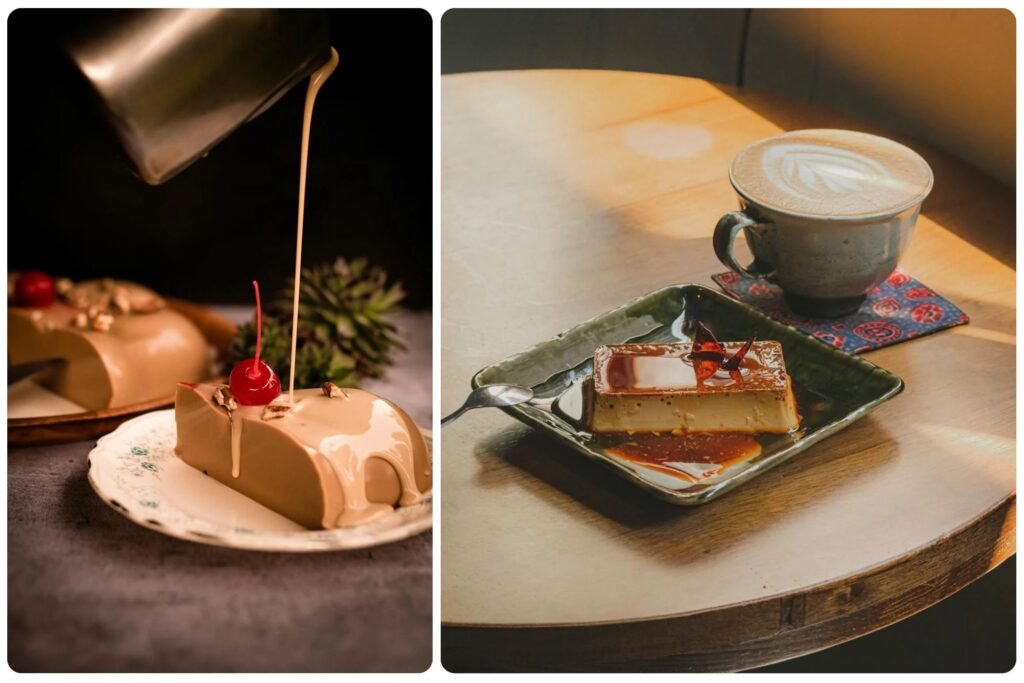
Image: Mexican flan with caramel sauce on decorative plate
Regional Sweet Specialties
- Dulce de Calabaza: Candied pumpkin, popular during Day of the Dead
- Arroz con Leche: Creamy rice pudding with cinnamon
- Cajeta: Goat’s milk caramel from Celaya, Guanajuato
For something completely different—refined but no less flavorful—explore French cuisine classics.
IX. Quenching Your Thirst: Traditional Mexican Beverages
After all that delicious food, it’s time to wash it down with something just as flavorful. Mexico’s traditional drinks—from fruity and refreshing to rich and smoky—are full of personality and regional flair.
Non-Alcoholic Mexican Drinks
Need a break between tacos and tamales? These classic non-alcoholic drinks will keep you cool, hydrated, and happily sipping like a local.
Agua Frescas: Refreshing Fruit Waters
These light, refreshing beverages are made from water blended with fruits, flowers, or seeds:
- Jamaica: Tart hibiscus flower drink
- Horchata: Sweet rice milk with cinnamon
- Tamarindo: Made from tamarind fruit
Café de Olla: Traditional Mexican Coffee
This aromatic coffee is brewed in a clay pot with cinnamon and piloncillo (unrefined cane sugar), creating a uniquely Mexican coffee experience.
Alcoholic Beverages of Mexico
If you’re curious about what locals sip during celebrations or quiet evenings, Mexico’s traditional alcoholic drinks offer stories in every glass.
The Agave Spirits: Tequila and Mezcal
No discussion of authentic Mexican drinks would be complete without mentioning these iconic agave-based spirits:
- Tequila: Made specifically from blue agave in designated regions
- Mezcal: Can be made from various agave species, known for its smoky flavor
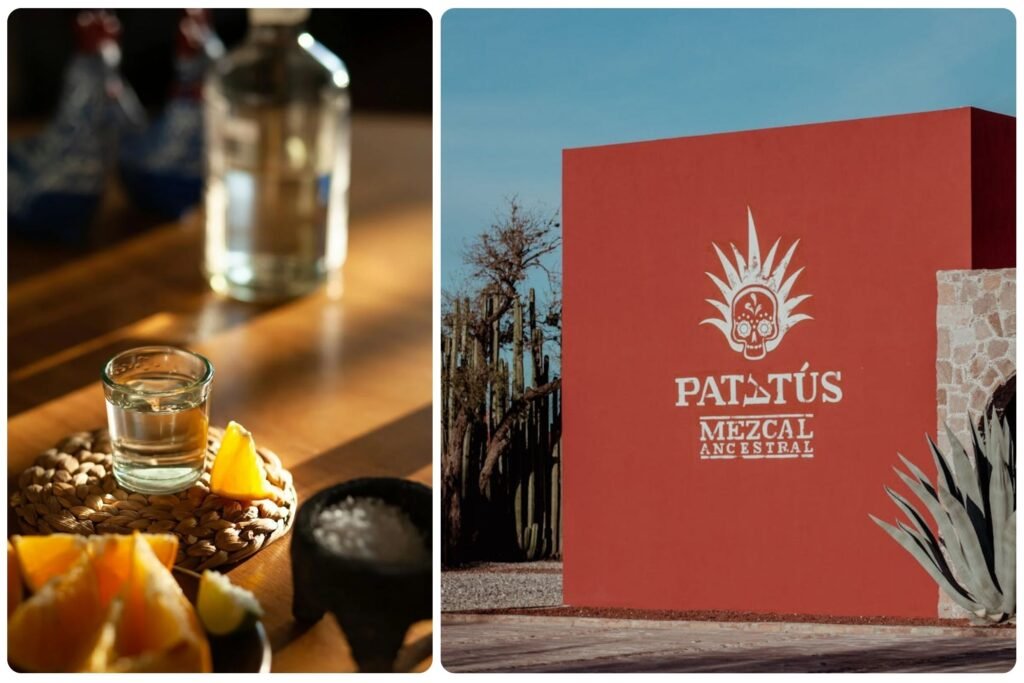
Image: Glasses of mezcal with orange slices and worm salt
Regional Alcoholic Specialties
Beyond tequila and mezcal, Mexico is home to other traditional drinks that reflect its rich cultural roots:
- Pulque: Ancient fermented agave drink, predating tequila
- Michelada: Beer cocktail with lime, salt, and spices

- Xtabentún: Anise liqueur from the Yucatán
Travel Tip: When sampling Mexico’s alcoholic beverages, moderation is key. Having reliable connectivity through Gohub’s eSIM services ensures you can always call a taxi or rideshare to get back to your accommodation safely.
Morocco’s spice game is just as strong. Check out local Moroccan foods to try.
X. Practical Tips for Food Explorers in Mexico
Eating your way through Mexico is an amazing adventure—but knowing a few tips can make your experience even more delicious (and stress-free!).
👀 How to Find the Best Local Food
- Follow the Locals: The golden rule: if there’s a line of locals at a food stall or small eatery, it’s probably amazing. Trust their taste.
- Go Beyond Tourist Areas: Some of the best food hides in neighborhoods off the tourist map. Don’t be afraid to explore! With a Gohub eSIM, you can use maps and translation apps confidently, even without Wi-Fi.
- Check Out Local Markets: Markets like Mercado de la Merced (Mexico City) or Mercado 20 de Noviembre (Oaxaca) are food heaven—packed with regional dishes, fresh ingredients, and local vibes.
🛡️ Food Safety Tips for Street Food Lovers
Eating street food is part of the experience—but it’s smart to be cautious:
- Choose busy stalls with high turnover
- Watch for clean hands and surfaces
- Make sure meat is cooked through
- Skip raw veggies unless you’re sure they’ve been washed properly
📱 Stay Connected, Eat Confidently
Whether you’re tracking down a hidden taco stand or translating a handwritten menu, having internet on the go is a lifesaver. With Gohub’s international eSIM, you can:
- Find reviews and local recommendations
- Translate ingredients or ask for help
- Share your location if needed
No roaming charges. No SIM swaps. Just smooth travel support, wherever you eat.friends or family while exploring Mexico’s culinary landscape.
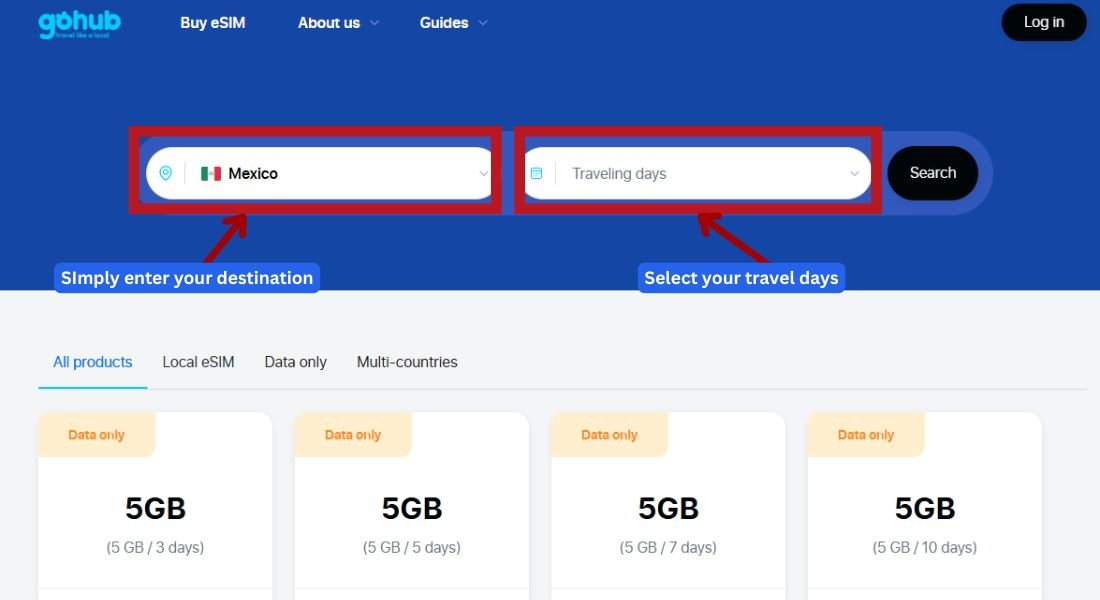
Image: Screenshot of the GoHub eSIM webpage, highlighting the destination input field with “Mexico” selected, illustrating how users can easily search for eSIM data plans.
👉 Explore GoHub’s Mexico eSIM plans now
XI. Conclusion: Embracing Mexico’s Culinary Heritage
The best local foods to try in Mexico go far beyond tacos. Every region has its own special dishes, made with love, history, and local ingredients. From the rich mole sauces of Oaxaca to the warm tamales and refreshing aguas frescas, authentic Mexican food is full of surprises.
These traditional Mexican dishes aren’t just tasty—they help you understand the country and its people. Eating like a local is one of the best ways to truly explore Mexico.
So be curious, be hungry, and don’t be afraid to try something new. And with a Gohub eSIM, you’ll always have maps, translations, and food tips right in your pocket—no roaming fees, no SIM swaps—just delicious discovery.
📶 From street tacos to mole in Oaxaca, don’t let Wi-Fi slow you down. Gohub’s Mexico eSIM gives you fast, reliable internet wherever your cravings take you.
➤ Get connected instantly and explore Mexico like a local foodie.
